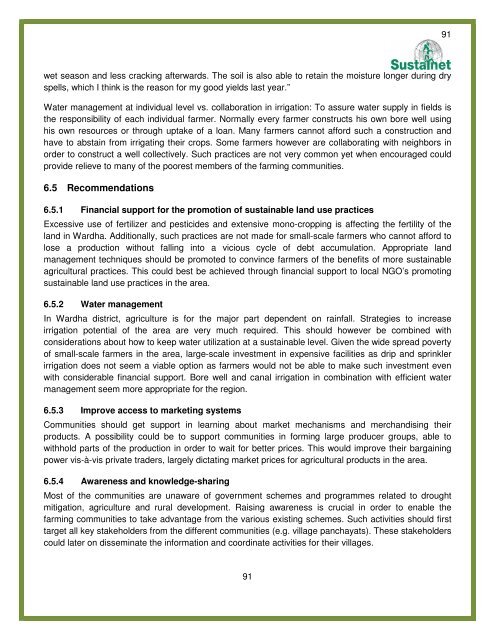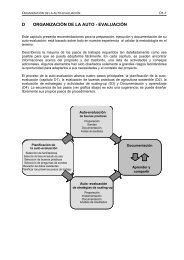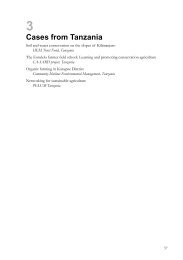Adaptation of small scale farmers to climatic risks in India - Sustainet
Adaptation of small scale farmers to climatic risks in India - Sustainet
Adaptation of small scale farmers to climatic risks in India - Sustainet
You also want an ePaper? Increase the reach of your titles
YUMPU automatically turns print PDFs into web optimized ePapers that Google loves.
wet season and less crack<strong>in</strong>g afterwards. The soil is also able <strong>to</strong> reta<strong>in</strong> the moisture longer dur<strong>in</strong>g dry<br />
spells, which I th<strong>in</strong>k is the reason for my good yields last year.”<br />
Water management at <strong>in</strong>dividual level vs. collaboration <strong>in</strong> irrigation: To assure water supply <strong>in</strong> fields is<br />
the responsibility <strong>of</strong> each <strong>in</strong>dividual farmer. Normally every farmer constructs his own bore well us<strong>in</strong>g<br />
his own resources or through uptake <strong>of</strong> a loan. Many <strong>farmers</strong> cannot afford such a construction and<br />
have <strong>to</strong> absta<strong>in</strong> from irrigat<strong>in</strong>g their crops. Some <strong>farmers</strong> however are collaborat<strong>in</strong>g with neighbors <strong>in</strong><br />
order <strong>to</strong> construct a well collectively. Such practices are not very common yet when encouraged could<br />
provide relieve <strong>to</strong> many <strong>of</strong> the poorest members <strong>of</strong> the farm<strong>in</strong>g communities.<br />
6.5 Recommendations<br />
6.5.1 F<strong>in</strong>ancial support for the promotion <strong>of</strong> susta<strong>in</strong>able land use practices<br />
Excessive use <strong>of</strong> fertilizer and pesticides and extensive mono-cropp<strong>in</strong>g is affect<strong>in</strong>g the fertility <strong>of</strong> the<br />
land <strong>in</strong> Wardha. Additionally, such practices are not made for <strong>small</strong>-<strong>scale</strong> <strong>farmers</strong> who cannot afford <strong>to</strong><br />
lose a production without fall<strong>in</strong>g <strong>in</strong><strong>to</strong> a vicious cycle <strong>of</strong> debt accumulation. Appropriate land<br />
management techniques should be promoted <strong>to</strong> conv<strong>in</strong>ce <strong>farmers</strong> <strong>of</strong> the benefits <strong>of</strong> more susta<strong>in</strong>able<br />
agricultural practices. This could best be achieved through f<strong>in</strong>ancial support <strong>to</strong> local NGO’s promot<strong>in</strong>g<br />
susta<strong>in</strong>able land use practices <strong>in</strong> the area.<br />
6.5.2 Water management<br />
In Wardha district, agriculture is for the major part dependent on ra<strong>in</strong>fall. Strategies <strong>to</strong> <strong>in</strong>crease<br />
irrigation potential <strong>of</strong> the area are very much required. This should however be comb<strong>in</strong>ed with<br />
considerations about how <strong>to</strong> keep water utilization at a susta<strong>in</strong>able level. Given the wide spread poverty<br />
<strong>of</strong> <strong>small</strong>-<strong>scale</strong> <strong>farmers</strong> <strong>in</strong> the area, large-<strong>scale</strong> <strong>in</strong>vestment <strong>in</strong> expensive facilities as drip and spr<strong>in</strong>kler<br />
irrigation does not seem a viable option as <strong>farmers</strong> would not be able <strong>to</strong> make such <strong>in</strong>vestment even<br />
with considerable f<strong>in</strong>ancial support. Bore well and canal irrigation <strong>in</strong> comb<strong>in</strong>ation with efficient water<br />
management seem more appropriate for the region.<br />
6.5.3 Improve access <strong>to</strong> market<strong>in</strong>g systems<br />
Communities should get support <strong>in</strong> learn<strong>in</strong>g about market mechanisms and merchandis<strong>in</strong>g their<br />
products. A possibility could be <strong>to</strong> support communities <strong>in</strong> form<strong>in</strong>g large producer groups, able <strong>to</strong><br />
withhold parts <strong>of</strong> the production <strong>in</strong> order <strong>to</strong> wait for better prices. This would improve their barga<strong>in</strong><strong>in</strong>g<br />
power vis-à-vis private traders, largely dictat<strong>in</strong>g market prices for agricultural products <strong>in</strong> the area.<br />
6.5.4 Awareness and knowledge-shar<strong>in</strong>g<br />
Most <strong>of</strong> the communities are unaware <strong>of</strong> government schemes and programmes related <strong>to</strong> drought<br />
mitigation, agriculture and rural development. Rais<strong>in</strong>g awareness is crucial <strong>in</strong> order <strong>to</strong> enable the<br />
farm<strong>in</strong>g communities <strong>to</strong> take advantage from the various exist<strong>in</strong>g schemes. Such activities should first<br />
target all key stakeholders from the different communities (e.g. village panchayats). These stakeholders<br />
could later on dissem<strong>in</strong>ate the <strong>in</strong>formation and coord<strong>in</strong>ate activities for their villages.<br />
91<br />
91




